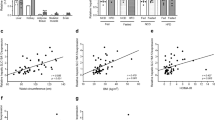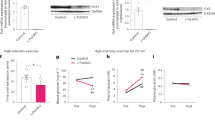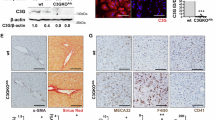Abstract
Suppression of excessive hepatic gluconeogenesis is an effective strategy for controlling hyperglycemia in type 2 diabetes (T2D). In the present study, we screened our compounds library to discover the active molecules inhibiting gluconeogenesis in primary mouse hepatocytes. We found that SL010110 (5-((4-allyl-2-methoxyphenoxy) methyl) furan-2-carboxylic acid) potently inhibited gluconeogenesis with 3 μM and 10 μM leading to a reduction of 45.5% and 67.5%, respectively. Moreover, SL010110 caused suppression of gluconeogenesis resulted from downregulating the protein level of phosphoenolpyruvate carboxykinase 1 (PEPCK1), but not from affecting the gene expressions of PEPCK, glucose-6-phosphatase, and fructose-1,6-bisphosphatase. Furthermore, SL010110 increased PEPCK1 acetylation, and promoted PEPCK1 ubiquitination and degradation. SL010110 activated p300 acetyltransferase activity in primary mouse hepatocytes. The enhanced PEPCK1 acetylation and suppressed gluconeogenesis caused by SL010110 were blocked by C646, a histone acetyltransferase p300 inhibitor, suggested that SL010110 inhibited gluconeogenesis by activating p300. SL010110 decreased NAD+/NADH ratio, inhibited SIRT2 activity, and further promoted p300 acetyltransferase activation and PEPCK1 acetylation. These effects were blocked by NMN, an NAD+ precursor, suggested that SL010110 inhibited gluconeogenesis by inhibiting SIRT2, activating p300, and subsequently promoting PEPCK1 acetylation. In type 2 diabetic ob/ob mice, single oral dose of SL010110 (100 mg/kg) suppressed gluconeogenesis accompanied by the suppressed hepatic SIRT2 activity, increased p300 activity, enhanced PEPCK1 acetylation and degradation. Chronic oral administration of SL010110 (15 or 50 mg/kg) significantly reduced the blood glucose levels in ob/ob and db/db mice. This study reveals that SL010110 is a lead compound with a distinct mechanism of suppressing gluconeogenesis via SIRT2-p300-mediated PEPCK1 degradation and potent anti-hyperglycemic activity for the treatment of T2D.
Similar content being viewed by others
Log in or create a free account to read this content
Gain free access to this article, as well as selected content from this journal and more on nature.com
or
References
Rizza RA. Pathogenesis of fasting and postprandial hyperglycemia in type 2 diabetes: implications for therapy. Diabetes. 2010;59:2697–707.
Han HS, Kang G, Kim JS, Choi BH, Koo SH. Regulation of glucose metabolism from a liver-centric perspective. Exp Mol Med. 2016;48:e218.
Magnusson I, Rothman DL, Katz LD, Shulman RG, Shulman GI. Increased rate of gluconeogenesis in type II diabetes mellitus. A 13C nuclear magnetic resonance study. J Clin Invest. 1992;90:1323–7.
Landau BR, Wahren J, Chandramouli V, Schumann W, Ekberg K. Contributions of gluconeogenesis to glucose production in the fasted state. J Clin Invest. 1996;98:378–85.
Foretz M, Guigas B, Viollet B. Understanding the glucoregulatory mechanisms of metformin in type 2 diabetes mellitus. Nat Rev Endocrinol. 2019;15:569–89.
Oh KJ, Han HS, Kim MJ, Koo SH. Transcriptional regulators of hepatic gluconeogenesis. Arch Pharm Res. 2013;36:189–200.
Pilkis SJ, Claus TH. Hepatic gluconeogenesis/glycolysis: regulation and structure/function relationships of substrate cycle enzymes. Annu Rev Nutr. 1991;11:465–515.
Nordlie RC, Lardy HA. Mammalian liver phosphoneolpyruvate carboxykinase activities. J Biol Chem. 1963;238:2259–63.
Beale EG, Harvey BJ, Forest C. PCK1 and PCK2 as candidate diabetes and obesity genes. Cell Biochem Biophys. 2007;48:89–95.
Burgess SC, He TT, Yan Z, Lindner J, Sherry AD, Malloy CR, et al. Cytosolic phosphoenolpyruvate carboxykinase does not solely control the rate of hepatic gluconeogenesis in the intact mouse liver. Cell Metab. 2007;5:313–20.
Yoon JC, Puigserver P, Chen GX, Donovan J, Wu ZD, Rhee J, et al. Control of hepatic gluconeogenesis through the transcriptional coactivator PGC-1. Nature. 2001;413:131–8.
Herzig S, Long F, Jhala US, Hedrick S, Quinn R, Bauer A, et al. CREB regulates hepatic gluconeogenesis through the coactivator PGC-1. Nature. 2001;413:179–83.
Jitrapakdee S. Transcription factors and coactivators controlling nutrient and hormonal regulation of hepatic gluconeogenesis. Int J Biochem Cell Biol. 2012;44:33–45.
Zhao SM, Xu W, Jiang WQ, Yu W, Lin Y, Zhang TF, et al. Regulation of cellular metabolism by protein lysine acetylation. Science. 2010;327:1000–4.
Jiang WQ, Wang SW, Xiao MT, Lin Y, Zhou LS, Lei QY, et al. Acetylation regulates gluconeogenesis by promoting PEPCK1 degradation via recruiting the UBR5 ubiquitin ligase. Mol Cell. 2011;43:33–44.
Seenappa V, Joshi MB, Satyamoorthy K. Intricate regulation of phosphoenolpyruvate carboxykinase (PEPCK) isoforms in normal physiology and disease. Curr Mol Med. 2019;19:247–72.
Zhang MM, Pan YD, Dorfman R, Yin YY, Zhou Q, Huang S, et al. Sirtinol promotes PEPCK1 degradation and inhibits gluconeogenesis by inhibiting deacetylase SIRT2. Sci Rep. 2017;7:7.
Zhang BJ, Pan YD, Xu L, Tang DH, Dorfman RG, Zhou Q, et al. Berberine promotes glucose uptake and inhibits gluconeogenesis by inhibiting deacetylase SIRT3. Endocrine. 2018;62:576–87.
Bian XL, Chen HZ, Yang PB, Li YP, Zhang FN, Zhang JY, et al. Nur77 suppresses hepatocellular carcinoma via switching glucose metabolism toward gluconeogenesis through attenuating phosphoenolpyruvate carboxykinase sumoylation. Nat Commun. 2017;8:14420.
Latorre-Muro P, Baeza J, Armstrong EA, Hurtado-Guerrero R, Corzana F, Wu LE, et al. Dynamic acetylation of phosphoenolpyruvate carboxykinase toggles enzyme activity between gluconeogenic and anaplerotic reactions. Mol Cell. 2018;71:718–32.e9.
Li XP, Chen YM, Shen ZJ, Pan Q, Yang WB, Yan H, et al. Epigallocatechin gallate inhibits hepatic glucose production in primary hepatocytes via downregulating PKA signaling pathways and transcriptional factor FoxO1. J Agric Food Chem. 2019;67:3651–61.
Xie W, Ye YL, Feng Y, Xu TF, Huang SL, Shen JH, et al. Linderane suppresses hepatic gluconeogenesis by inhibiting the cAMP/PKA/CREB pathway through indirect activation of PDE 3 via ERK/STAT3. Front Pharmacol. 2018;9:476.
Liu SW, Huang SL, Wu XD, Feng Y, Shen Y, Zhao QS, et al. Activation of SIK1 by phanginin A inhibits hepatic gluconeogenesis by increasing PDE4 activity and suppressing the cAMP signaling pathway. Mol Metab. 2020;41:101045.
He L, Naik K, Meng SM, Cao J, Sidhaye AR, Ma AL, et al. Transcriptional co-activator p300 maintains basal hepatic gluconeogenesis. J Biol Chem. 2012;287:32069–77.
Black JC, Mosley A, Kitada T, Washburn M, Carey M. The SIRT2 deacetylase regulates autoacetylation of p300. Mol Cell. 2008;32:449–55.
Papeleu P, Vanhaecke T, Henkens T, Elaut G, Vinken M, Snykers S, et al. Isolation of rat hepatocytes. In: Phillips IR, Shephard EA, editors. Cytochrome P450 protocols. Totowa, New Jersey, USA: Humana Press; 2006. p. 229–37.
Wan W, You ZY, Xu YF, Zhou L, Guan ZL, Peng C, et al. mTORC1 phosphorylates acetyltransferase p300 to regulate autophagy and lipogenesis. Mol Cell. 2017;68:323–35.e6.
Zhou S, Tang X, Chen HZ. Sirtuins and insulin resistance. Front Endocrinol. 2018;9:748.
Hughey CC, Wasserman DH, Lee-Young RS, Lantier L. Approach to assessing determinants of glucose homeostasis in the conscious mouse. Mamm Genome. 2014;25:522–38.
Lee CM, Kumar V, Riley RI, Morgan ET. Metabolism and action of proteasome inhibitors in primary human hepatocytes. Drug Metab Dispos. 2010;38:2166–72.
Grohmann T, Penke M, Petzold-Quinque S, Schuster S, Richter S, Kiess W, et al. Inhibition of NAMPT sensitizes MOLT4 leukemia cells for etoposide treatment through the SIRT2-p53 pathway. Leuk Res. 2018;69:39–46.
Ying W. NAD+/NADH and NADP+/NADPH in cellular functions and cell death: regulation and biological consequences. Antioxid Redox Signal. 2007;10:179–206.
Katsyuba E, Romani M, Hofer D, Auwerx J. NAD+ homeostasis in health and disease. Nat Metab. 2020;2:9–31.
Zhang XP, Yang SS, Chen JLL, Su ZG. Unraveling the regulation of hepatic gluconeogenesis. Front Endocrinol. 2019;9:802.
Rines AK, Sharabi K, Tavares CDJ, Puigserver P. Targeting hepatic glucose output in the treatment of type 2 diabetes. Nat Rev Drug Discov. 2016;15:786.
Glickman MH, Ciechanover A. The ubiquitin-proteasome proteolytic pathway: destruction for the sake of construction. Physiol Rev. 2002;82:373–428.
Sasaki T, Gan EC, Wakeham A, Kornbluth S, Mak TW, Okada H. HLA-B-associated transcript 3 (Bat3)/Scythe is essential for p300-mediated acetylation of p53. Genes Dev. 2007;21:848–61.
Sebti S, Prebois C, Perez-Gracia E, Bauvy C, Desmots F, Pirot N, et al. BAG6/BAT3 modulates autophagy by affecting EP300/p300 intracellular localization. Autophagy. 2014;10:1341–2.
Goodman RP, Calvo SE, Mootha VK. Spatiotemporal compartmentalization of hepatic NADH and NADPH metabolism. J Biol Chem. 2018;293:7508–16.
Chang AY, Gilchrist BJ, Wyse BM. Ciglitazone, a new hypoglycaemic agent. 3. effect on glucose disposal and gluconeogenesis in vivo in C57BL/6J-Ob/Ob and –+/? Mice. Diabetologia. 1983;25:514–20.
Fukudo S, Virnelli S, Kuhn CM, Cochrane C, Feinglos MN, Surwit R, et al. Muscarinic stimulation and antagonism and glucoregulation in nondiabetic and obese hyperglycemic mice. Diabetes. 1989;38:1433–8.
Acknowledgements
This work was supported by grants from Science and Technology Commission of Shanghai Municipality (19431900900).
Author information
Authors and Affiliations
Contributions
YL, JHS, and SLH designed the research. YRR, YLY, YF, TFX, YS, and JL performed the research. YRR, SLH, and YL analyzed and interpreted the data. YRR, SLH, and YL wrote the paper.
Corresponding authors
Ethics declarations
Competing interests
The authors declare no competing interests.
Rights and permissions
About this article
Cite this article
Ren, Yr., Ye, Yl., Feng, Y. et al. SL010110, a lead compound, inhibits gluconeogenesis via SIRT2-p300-mediated PEPCK1 degradation and improves glucose homeostasis in diabetic mice. Acta Pharmacol Sin 42, 1834–1846 (2021). https://doi.org/10.1038/s41401-020-00609-w
Received:
Accepted:
Published:
Issue date:
DOI: https://doi.org/10.1038/s41401-020-00609-w
Keywords
This article is cited by
-
Untargeted metabolomic and proteomic analysis implicates SIRT2 as a novel therapeutic target for diabetic nephropathy
Scientific Reports (2025)
-
TRIM21 ameliorates hepatic glucose and lipid metabolic disorders in type 2 diabetes mellitus by ubiquitination of PEPCK1 and FASN
Cellular and Molecular Life Sciences (2023)



